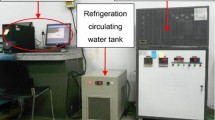Abstract
Water penetration in porous building materials can cause damage in building components exposed to wet environmental conditions. A system to monitor water penetration by means of electrical conductivity measurements is presented (Gummerson et al. Build Environ 15:101–108, 1980). The sensor allows non-destructive and continuous monitoring of different layers of building envelopes with high space and time resolution. Capillary uptake experiments have been performed to assess the reliability of the developed system. Sensors data are compared to the results of the analysis of neutron radiographs taken during the experiments. These sensors are easy to apply in different positions, even deep in the structural components where direct gravimetric investigation is not possible. Electrical conductivity measurements provide a good temporal description of the capillary uptake process, however a calibration for moisture content quantification could not yet be achieved.












Similar content being viewed by others
References
Archie GE (1942) The electrical resistivity log a s an aid in determining some reservoir characteristics. Pet Trans AIME 146:54–62
Berliner MA (1980) Feuchtemessung. VEB Verlag Technik, Berlin
Birlea NMC, Culea EN (2012) Electrical methods for testing buildings and construction materials. In: Proceedings of first international conference for PhD students in Civil Engineering, CE-PhD, 4–7 Nov Cluj_Napoca, Romania
Courtois, A., Taillade, F., Moreau, G., Clauzon, T., Skoczylas, F., Masson, B, 2013, Water content monitoring for nuclear concrete buildings: needs, feedback and perspectives, PoromechanicsV, ASCE
Daniels DJ (2004) Ground-penetrating radar. Institute of Electrical Engineers, London
Dean TJ, Bell JP, Baty AJB (1987) Soil moisture measurement by an improved capacitance technique. Sensor design and performance. J Hydrol 93:67–78
Ewing RP, Hunt AG (2006) Dependence of the electrical conductivity on saturation in real porous media. Vadose Zone J 5:731–741
Guizzardi M (2014) Hygrothermal performance assessment of novel interior insulation solutions. Ph.D. Thesis, Chair of Building Physics, ETH Zürich
Gummerson RJ, Hall C, Hoff WD (1980) Water movement in porous building materials—II. Hydraulic Suction and Sorptivity of Brick and Other Masonry Materials. Build Environ 15:101–108
Hassanein R (2006) Correction methods for the quantitative evaluation of thermal neutron tomography. Ph.D. Thesis, ETH Zürich, Switzerland
Hassanein R, Meyer H, Carminati A, Estermann M, Lehmann E, Vontobel P (2006) Investigation of water imbibition in porous stone by thermal neutron radiography. J Phys D: Appl Phys 39(19):4284–4291
Krus M (1995) Moisture transport and storage coefficients of porous mineral building materials. Ph.D. Thesis, Universität Stuttgart, Germany
Kupfer K (1990) Feuchtemessung an Zuschlagstoffen für die Betonherstennung unter Verwendung der Mikrowellenmesstechnik. Dissertion, Hochschule für Architektur und Bauwesen Wismar
Leschnik W (1999) Feuchtemessung an Baustoffen—Zwischen Klassik und Moderne, Feuchtetag `99. Umwelt Meßverfahren Anwendungen, 7/8 Oktober 1999, BAM, Berlin
McCarter WJ, Vennesland O (2004) Sensor systems for use in reinforced concrete structures. Contr Build Mater 18:351–358
Pel L (1995) Moisture transport in porous materials. PhD Thesis, TU/e, Eindhoven, The Netherlands
Plack GV (1987) Resistivity characteristcs of geological targets. Electromag Methods Appl Geophys 1 (Theory), p 1351
Rajabipour F. 2006. Insitu electrical sensing and material health monitoring in concrete structures. PhD thesis, Publication Number: AAI3259972, Purdue University
Rajabipour F, Weiss J (2007) Electrical conductivity of drying cement paste. Mater Struct 40:1143–1160
Raupach M, Schiessl P (2001) Macrocell sensor systems for monitoring of the corrosion risk of the reinforcement in concrete structure. NDT E Int 34:435–442
Sandrolini F, Franzoni E (2006) An operative protocol for reliable measurements of moisture in porous materials of ancient buildings. Build Environ 41:1372–1980
Sedighi Gilani M, Griffa M, Mannes D, Lehmann E, Carmeliet J, Derome D (2012) Visualization and quantification of liquid water transport in softwood by means of neutron radiography. Int J Heat Mass Transf 55:6211–6221
Author information
Authors and Affiliations
Corresponding author
Rights and permissions
About this article
Cite this article
Guizzardi, M., Derome, D., Mannes, D. et al. Electrical conductivity sensors for water penetration monitoring in building masonry materials. Mater Struct 49, 2535–2547 (2016). https://doi.org/10.1617/s11527-015-0666-7
Received:
Accepted:
Published:
Issue Date:
DOI: https://doi.org/10.1617/s11527-015-0666-7




